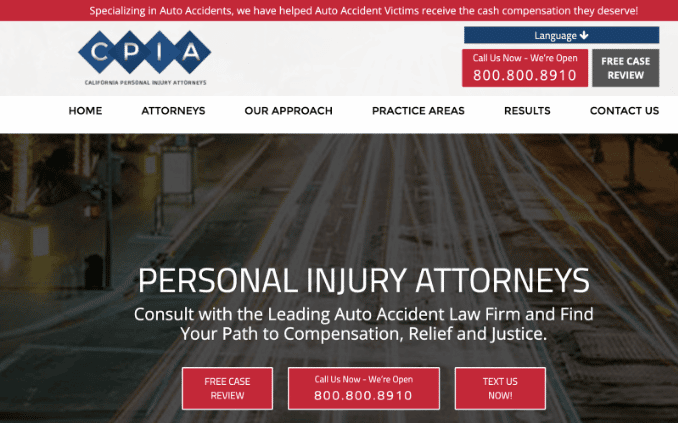When you see the Nike swoosh, do the words “Just Do It” come to mind? Or when you hear “Give me a break”, do you finish it with “Break me off a piece of that Kit-Kat bar”? Your law firm may not have slogans or jingles, but it should always have a silent communicator—its brand.
Law firm branding goes beyond a tagline, logo, or website design. It sets you apart in a crowded legal landscape, winning over clients and building brand awareness.
But what exactly is legal branding? And where does one even start to work branding into their legal practice?
In this article, we’ll answer both these questions and more. Join us as we cover the basics of law firm branding, why it matters, and how you can leverage it to win more clients.
What Is Law Firm Branding?
Law firm branding uses a mix of tangible and intangible elements to communicate your firm’s story and values to your target audience. This includes your advertisements, website, logo, and even your lawyer-client interactions. Think of it like the personality of your firm. Ultimately, legal branding is about establishing a strong identity that attracts the right clients and leaves a positive, lasting impression.
Why Is Law Firm Branding Important?

According to the latest data from the American Bar Association, there are 1.3 million lawyers in the United States. And even though practicing law is at the heart of your firm, it’s also important to remember that you’re running a business. For your business to be successful, you need clients.
So, what does that mean? You have to convince clients that your firm is the best for the job.
Law firm branding helps you achieve this. Let’s look at the benefits of effective branding for law firms:
Benefits of Law Firm Branding
Increased brand awareness creates a buzz around your firm
Unified firm identity creates a cohesive experience for your team and clients
Differentiated market positioning helps you stand out in your geographical location and practice area
Improved client targeting attracts clients aligned with your firm’s values, specialties and expertise
Optimized marketing efforts ensure that every campaign supports your overall brand message
Examples of Legal Branding Scenarios
Now that we know the benefits of strong branding, let’s look at how branding can shape a positive, or negative, experience for your clients.
Let’s start with the good.
Let’s say someone is looking for a divorce attorney. After a quick Google search, they end up on your firm’s website. They find a modern, clean web design, professional lawyer headshots, positive testimonials from other divorcees, and helpful legal content. As they’re navigating your site, you’re subconsciously earning their trust. And if you’ve done a good job of matching your website to your firm’s branding, they’ll be likely to seek your legal assistance.
Now, let’s imagine this scenario with a less favorable outcome.
Say their Google search leads them to a website that is slow to load and difficult to navigate. On top of that, it looks like it has been updated for years. There is no mention of family law of divorce practice, so they move on. You have lost this client.
There are too many modern law firms out there to get clients to look past any faulty interactions (via website, phone, chat, etc.). In the above scenarios, we played with a tangible element, the website, to show how you can convert or lose a client. To compete, you need to be prepared for any interaction whenever it happens.
The Core Components of Legal Branding
Developing and executing a branding campaign that yields results can be overwhelming. After all, establishing a brand takes time. Instead, take it one step at a time. Below we’ve broken down the core components of attorney branding to guide you through your journey:
1. Branding Elements
There are tangible and intangible aspects of your firm’s brand. Tangible parts of branding a law firm include visuals such as:
Logo
Color scheme
Tagline
Imagery
These visual aspects should be consistent across your firm’s main advertising channels. This includes your website, print advertisements, social media, Google ads, and Google business profile. Using the same visual branding helps your firm become recognizable. You may consider hiring a designer or marketing consultant to ensure all of your materials and tangible elements are cohesive.
Intangible elements of law firm branding include the mental associations and emotions people experience when they think of your firm. This is represented by:
Messaging
Voice
Presence
Service
Values
Use these elements to create a brand guide and build a roadmap for kick-starting your campaign.
2. Unique Selling Proposition
At the core of a strong brand is a unique selling proposition (USP). This is the differentiating factor that sets your brand and firm apart from competitors. When determining your firm’s USP, be as specific as possible. Ask yourself—what advantages do you offer clients that other lawyers don’t? How can you show that in your branding? Write out your USP and refer to it when executing your brand campaign.
3. Brand Promise
A brand promise communicates to current and potential clients the values that matter most to your firm. Write your brand promise as a short value statement that puts clients first. This approach will help position your firm in a positive light and keep it front of mind. It can even be used as part of your digital marketing.
For example, the Nevada Family Law Group reflects its firm’s values on its home page with its statement and imagery on the importance of families. This approach will likely resonate better with clients and increase the chances of scheduling a consultation.
4. Brand Messaging and Voice
Clear and consistent messaging and voice are essential for lawyer branding. Brand messaging should concisely represent your firm’s offerings and speak to your target audience. Avoid using too much legal jargon, which may confuse or intimidate clients. Your messaging should be straightforward, professional, and clearly state what clients can expect from working with you.
Developing a brand voice will look different for each firm and practice area. Your voice should represent your brand promise and values in tone and language. For example, if you are in family law, your firm will likely want to use compassionate, warm, empathetic language. Whereas if you are a corporate law firm, you may consider using a more straightforward approach.
For instance, the California Personal Injury Attorneys (pictured below) make it very clear to anyone who visits their site that they practice personal injury law in direct and concise language. They also make it very easy to connect them with a clear call-to-action (CTA) and texting option.

5. Target Audience
You should build your brand around your target audience. Untargeted marketing and lawyer branding efforts are ineffective and waste firm funds. Purposefully targeting an audience during your branding campaign will help attract clients that are the best fit for your firm. For example, you should ask yourself:
Who do you want to provide legal services for?
What does your ideal client look like?
Multiple personas may fit into your ideal clientele, and that’s ok. Create a persona (or numerous personas) of your ideal client to help guide your branding. These personas should be specific and include information about demographics such as age, location, gender, average income, education level, job title, industry, values, pain points, budgets, goals, and so on.
For example, the Moore Family Law Group showcases clearly targeted demographics in their messaging:

6. Positioning
Once you’ve determined the core aspects of your law firm’s branding, position your firm as an expert in your practice area. Building your brand takes time, strategic planning, and financial investment. Invest in online marketing to gain visibility, become a reputable legal source, and familiarize yourself with the ethics of online marketing and branding for law firms, so you stay in compliance.
In addition, the American Bar Association has some great resources for growing your practice.
Use Branding to Win More Clients With the Help of MyCase
Now that you’re ready to invest in your law firm’s branding, consider utilizing legal management software to reinforce your brand identity.
MyCase can position your firm as a leader with a custom, professional website connected to your MyCase platform. This white-glove service helps you stand out against the competition and effectively communicate your brand to current and future clients.
MyCase also allows you to create custom invoices that accurately represent your practice. Choose from invoice themes to select the best one for your firm. Branding is in the details, and MyCase is here to make yours a success.
Try a risk-free 10-day free trial to see firsthand how MyCase can help you manage your legal practice and enhance your brand to win more clients. No credit card or commitment required.
Lawyer Branding FAQs
About the author

Mary Elizabeth HammondSenior Content Writer
Mary Elizabeth Hammond is a Senior Content Writer and Blog Specialist for leading legal software companies, including MyCase, Docketwise, and CASEpeer, as well as LawPay, the #1 legal payment processor. She covers emerging legal technology, financial wellness for law firms, the latest industry trends, and more.
